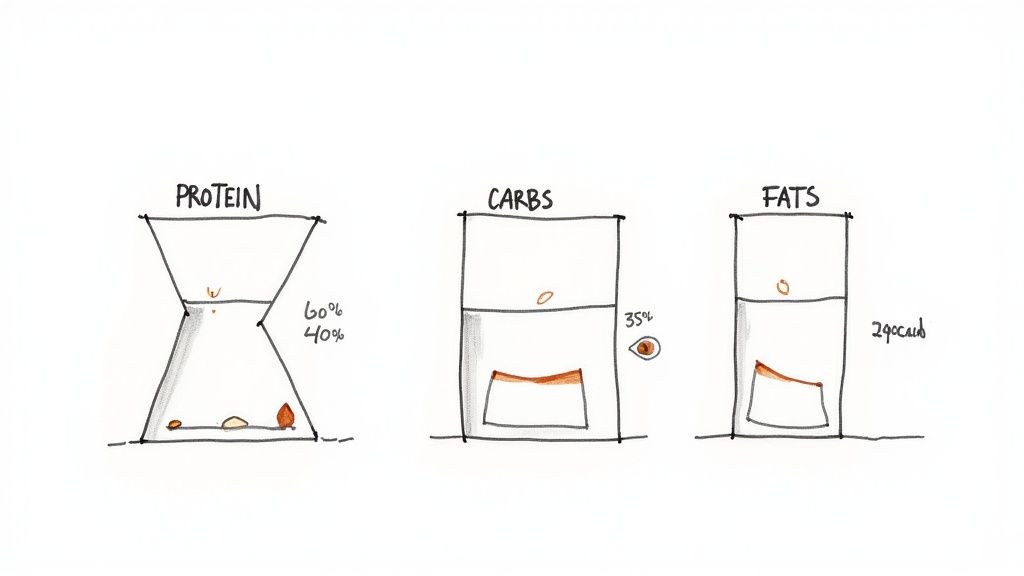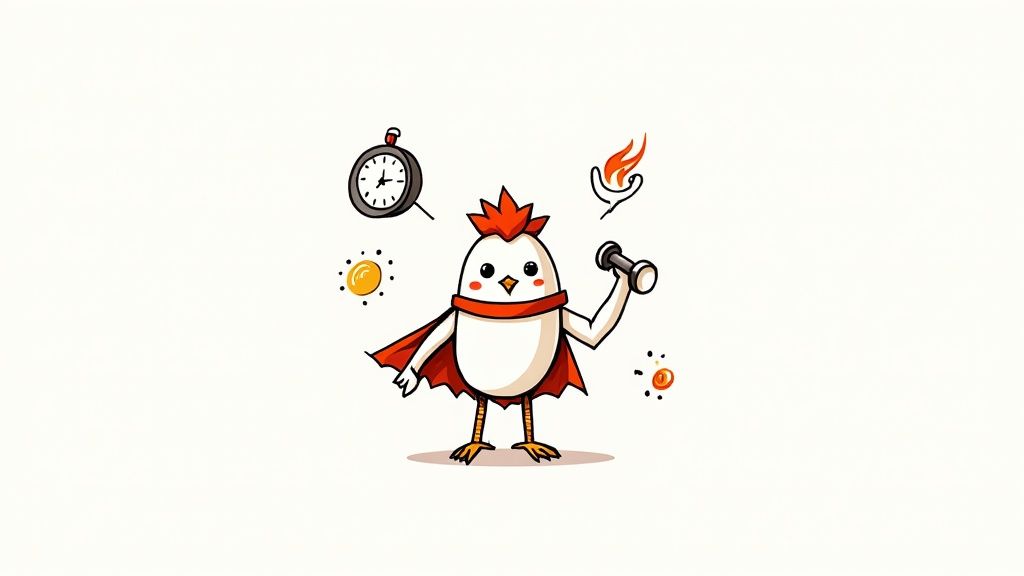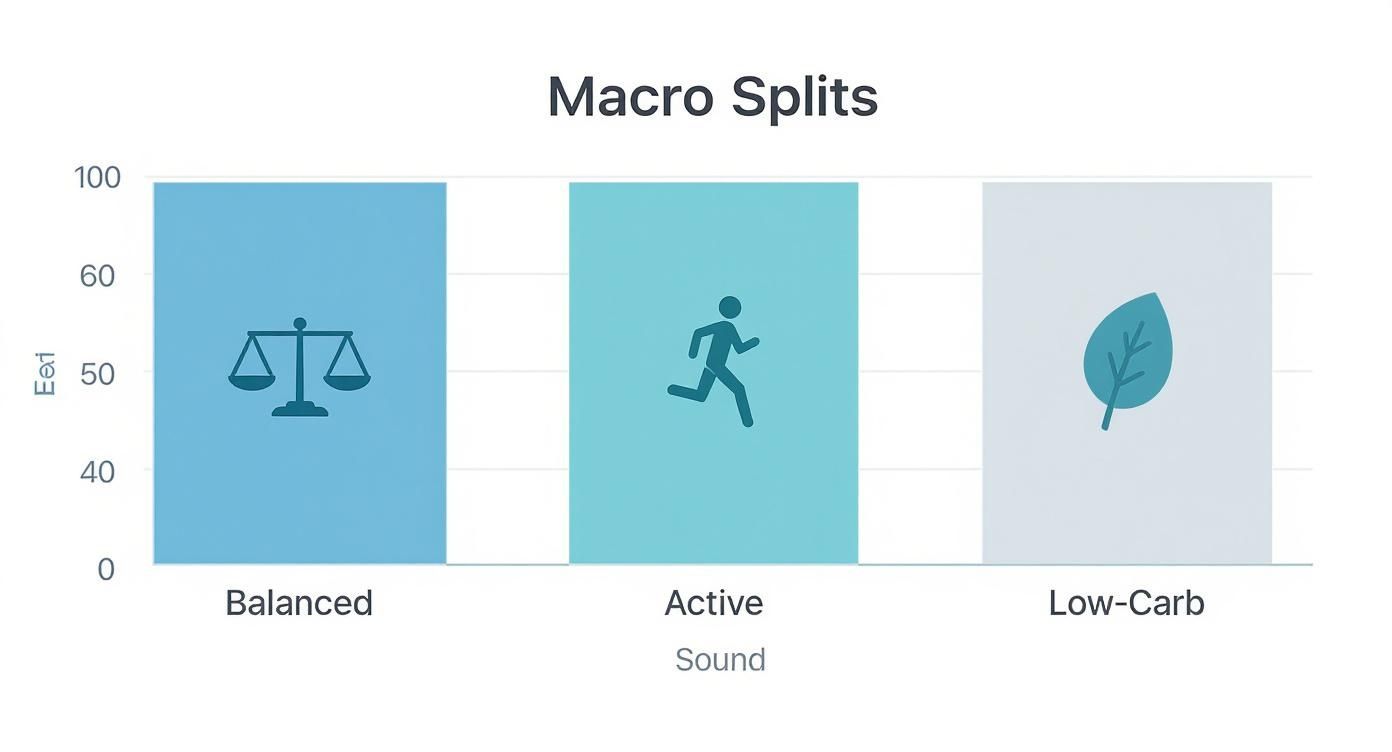What Macros to Lose Weight? A Simple Guide for Real Life
Confused about what macros to lose weight? This guide breaks down protein, carbs, and fats in simple terms to help you reach your goals without the stress.
Posted by
So, you're curious about the best macros for losing weight but don't want to get lost in complicated math. Good news—it's way simpler than you think. The basic idea? Prioritize protein, be smart about carbs, and don't fear healthy fats.
A great starting point for many people is a 40/30/30 split: 40% of your daily calories from carbs, 30% from protein, and 30% from fat. But think of this as a launchpad, not a rigid rule. Your ideal balance is unique to you, and finding it should feel easy, not stressful.
Your Quick Guide to Weight Loss Macros

If the word "macros" makes you think of intense meal prepping and spreadsheets, let's clear that up. It's much simpler. Macros, short for macronutrients, are just the three main nutrients your body uses for energy: protein, carbohydrates, and fats.
Let's break them down without the textbook jargon:
- Protein: Think of this as your body's repair crew. It helps rebuild muscle and, most importantly, keeps you feeling full and satisfied long after you eat.
- Carbohydrates: This is your primary fuel. Carbs give you the energy you need for everything, from a morning walk to focusing at work.
- Fats: These are your body's support system. Healthy fats are essential for balancing hormones and absorbing vitamins. They are definitely not the enemy!
When it comes to weight loss, we’re not trying to eliminate any of these. The goal is to find a balance that helps your body burn fat while holding onto muscle and keeping your energy levels stable.
A Simple Starting Point
Getting started is often the hardest part, but it doesn't have to be a headache. A balanced macro split is usually the easiest to stick with. If you’re just dipping your toes in, our guide on how to count macros for beginners can help you learn the ropes without the overwhelm.
The real secret is to see macros as a flexible guide, not a set of strict rules. It’s about being more mindful of your food choices, not obsessing over every single gram. A little awareness goes a long way.
To make things even easier, here’s a quick cheat sheet with some common macro splits. Use this to find a starting point that feels right, and then adjust as you learn what works for you.
Starting Macro Percentages for Weight Loss
This table shows some common macro splits that can help you find a balanced starting point on your weight loss journey.
| Macronutrient | Role in Weight Loss | Recommended % of Daily Calories |
|---|---|---|
| Protein | Keeps you full, preserves muscle | 30-40% |
| Carbohydrates | Provides sustained energy for activity | 30-40% |
| Fat | Supports hormones and vitamin absorption | 20-30% |
Remember, the best macro split is the one you can stick with while feeling energized and seeing progress. Don't be afraid to experiment!
Why Protein Is Your Best Friend for Weight Loss

If macros were a team, protein would be the captain when it comes to weight loss. It's not just for bodybuilders—it's a powerful tool that makes shedding pounds feel more manageable and sustainable for everyone.
Think of protein as your secret weapon against hunger. It's the most filling macronutrient, helping you feel satisfied long after a meal. That grilled chicken salad you had for lunch? The protein is what helps you sail through the afternoon without getting tempted by those breakroom snacks.
This feeling of fullness is a total game-changer. It helps you naturally eat fewer calories throughout the day, often without even trying.
Protect Your Progress
When you cut calories, your body looks for energy wherever it can find it. Unfortunately, that sometimes means breaking down muscle tissue, not just fat. This is where protein comes in to save the day.
Getting enough protein tells your body to preserve lean muscle while you're losing fat. This is super important because muscle is like your body's metabolic engine—it burns more calories at rest than fat does. By protecting that muscle, you keep your metabolism running smoothly.
A higher protein diet isn't just about feeling full; it's a smart move to ensure the weight you lose is primarily fat, not muscle. This leads to better, more sustainable results.
The Thermic Effect of Food
Here’s another cool thing about protein. Your body actually burns calories just by digesting the food you eat. It’s a process called the thermic effect of food (TEF), and protein has the highest TEF of all the macros.
Your body uses more energy to process protein (20-30% of its calories) compared to carbs (5-10%) and fats (0-3%). While it's not a massive calorie burn, this little metabolic boost adds up over time, giving you a slight edge on your weight loss journey.
Making sure you're getting enough is pretty simple. Research shows that diets where 25-30% of calories come from protein often lead to better weight loss results. If you're wondering what's right for you, our guide on how to calculate your daily protein needs breaks it down simply.
Effortless logging makes hitting your protein goal easy. Just saying, "chicken salad for lunch," or "protein shake after my workout," into munchlog.ai lets you see if you're on track, turning this simple habit into an easy part of your day.
Making Peace with Carbs and Fats
https://www.youtube.com/embed/E6WSzDJrnDs
For years, carbs and fats have been painted as the villains of weight loss. We've all heard it: skip the bread, avoid pasta, and run from anything fatty. But the truth is, your body actually needs both of them to function at its best. The secret isn't cutting them out, but choosing the right kinds.
Think of it like fuel for a fire. Some wood burns out in a quick flash, while other logs burn slow and steady, providing warmth for hours. The carbs you eat work the same way.
Choosing Your Fuel Wisely
Simple carbs—found in things like white bread, sugary drinks, and candy—are the quick-burning kind. They give you a fast jolt of energy followed by a crash, which often leaves you feeling hungry again pretty quickly.
Complex carbs are the long-lasting fuel. You'll find these in foods like:
- Oats
- Brown rice
- Quinoa
- Sweet potatoes
- Beans and lentils
These foods break down slowly, giving you a steady stream of energy that keeps you feeling full for hours. They’re also packed with fiber, which is great for digestion. Simple swaps, like choosing brown rice over white, can make a huge difference in your energy levels.
Embracing Healthy Fats
The old "fat is bad" idea is just a myth. Healthy fats are absolutely essential. They’re critical for balancing hormones, keeping your brain healthy, and helping your body absorb certain vitamins. They also play a huge role in making you feel full.
Great sources include avocados, nuts, seeds, and quality olive oil. When you welcome healthy fats back into your diet, it's cool to see how they can support your goals. For instance, looking into the science behind using extra virgin olive oil for weight loss shows how a simple, healthy addition can make a difference.
Don't fear the avocado on your toast or a handful of almonds as a snack. These foods are your allies, providing sustained energy and key nutrients that support a healthy metabolism and make your weight loss journey feel much more enjoyable.
The goal isn't restriction; it's about smart balance. A good macro split for weight loss often looks something like 40-50% carbs, 25-35% protein, and 20-30% healthy fats, though your ideal numbers might vary.
Tracking these foods doesn't have to be a chore. A quick voice command—like, "oatmeal with berries for breakfast," or "salad with chicken and avocado"—is an easy way to stay mindful without the stress. It helps you see how balanced your meals are and allows you to make small, smart adjustments along the way.
How To Find Your Personal Macro Balance
So, what are the perfect macros to lose weight? The truth is, there's no single magic formula that works for everyone. Your ideal split depends on your body, your activity level, your lifestyle, and even the foods you genuinely enjoy.
Think of it like getting a custom-tailored outfit versus buying one off the rack. The goal is to find a fit that feels right for you—one that gives you energy, keeps you full, and helps you lose weight without making you miserable. It's all about creating a sustainable plan you can actually stick with.
Finding Your Starting Point
Getting started is way simpler than it sounds. You don't need a calculator or complicated formulas. Most people do great with a balanced approach that doesn’t cut out any food group. Just pick a reasonable starting point, pay attention to how your body feels, and make small tweaks from there.
If you want to get more specific, a good protein-carb-fat ratio calculator can give you a personalized recommendation. But remember, that number is a starting line, not a finish line. The real progress happens when you learn to listen to your body.
Think of your macro targets as a friendly guide, not a strict rulebook. The goal is to become more aware of what you're eating and gently nudge your habits in a healthier direction. Flexibility is what makes this work long-term.
Once you have a general idea of your macros, it can be helpful to see what that looks like in a day. For example, if you're aiming for around 1500 calories, you can see how to build satisfying meals with a detailed 1500-calorie diet plan that also keeps macros in mind.
To give you a better sense of how this looks in the real world, let's explore a few common macro splits. See which one feels like the best fit for your lifestyle and use it as your initial roadmap.
Example Macro Splits for Different Lifestyles
This table lays out a few different macro ratios for common goals. It's designed to help you find a starting point that feels achievable.
| Lifestyle Goal | Protein % | Carbohydrate % | Fat % |
|---|---|---|---|
| Balanced Weight Loss | 35% | 40% | 25% |
| Active & Fitness Focused | 30% | 45% | 25% |
| Lower-Carb Preference | 40% | 30% | 30% |
These are just examples, of course, but they show how you can shift your macros to better support your goals.
The best part about casual macro tracking is that you can see these patterns without the stress. Simply logging what you eat helps you see if you're in the ballpark. Over time, you’ll get a feel for what works and can make small adjustments to find that perfect balance for you.
A Day of Effortless Macro Tracking
Theory is one thing, but what does this actually look like on a normal, busy day? It's easy to get bogged down in the "how" of tracking, making it feel like a chore. Let's walk through a day of tracking macros without the stress.
The goal here isn't perfection; it's about awareness. Forget weighing every ingredient or typing into complicated spreadsheets. With a tool like munchlog.ai, you can just use your voice to log meals, and it does the heavy lifting of figuring out your proteins, carbs, and fats.
A Day in the Life
Picture a typical Tuesday. You're juggling work, maybe squeezing in a walk, and just trying to eat well. Here’s how you could track your food without skipping a beat.
- Morning Coffee: On your way out the door, you grab your usual. Instead of opening an app to type it all in, you just say, "iced coffee with a splash of oat milk." The app logs it and estimates the macros. Done.
- Quick Lunch: You packed a salad (go you!). After you eat, you simply say, "big salad with grilled chicken, mixed greens, and vinaigrette." That’s it. No need to look up each ingredient; the breakdown is handled for you.
This casual approach keeps you in the loop without feeling restrictive. You're getting a gentle, real-time snapshot of how your meals are stacking up against your goals.
Afternoon and Evening Wind-Down
As the day goes on, the tracking stays just as simple. You’ll start to see your daily patterns emerge without any extra mental energy.
- Afternoon Snack: Feeling a little peckish, you grab a handful of almonds. You log it by saying, "a handful of almonds." This quick entry instantly shows you how you're doing on your healthy fat and protein goals for the day.
- Homemade Dinner: You whip up a simple dinner—tonight, it's spaghetti with turkey meatballs. All it takes is saying, "a bowl of spaghetti with turkey meatballs and marinara sauce."
At the end of the day, you can glance at your log. Maybe you’ll notice your protein was spot-on, but your carbs were a little higher than you planned. That’s not a failure; it’s just information. Tomorrow, you might add extra veggies to your salad or have a slightly smaller portion of pasta. No big deal.
This infographic shows a few common macro splits, illustrating how different lifestyles might adjust their protein, carb, and fat intake.

As you can see, the ratios can shift depending on whether your goal is balanced weight loss, fueling an active lifestyle, or following a lower-carb plan.
The beauty of effortless tracking is that it empowers you to make small, informed adjustments. It’s not about a perfect day; it’s about consistent awareness that leads to lasting, healthy habits.
Answering Your Top Macro Tracking Questions
Getting started with macros can bring up a few questions. Let's clear up some of the most common ones.
Do I Have to Hit My Macros Perfectly Every Single Day?
Absolutely not. This is probably the biggest sigh of relief for anyone starting out. Chasing perfection is a recipe for burnout.
Think of your macro targets as a friendly guide, not a strict rulebook. Some days you might be a little over on carbs, and other days you might hit your protein goal perfectly. It’s all part of the process. The real goal is consistency over the week, not flawless execution every single day.
Is It Better to Focus on Macros or Calories?
This is a great question, and the answer is: they work together. For weight loss to happen, you need to be in a calorie deficit (burning more than you eat). That's a must.
But where those calories come from (your macros) is what determines the quality of your weight loss. Getting enough protein, for example, helps you hold onto muscle and feel full, which makes staying in that calorie deficit way easier.
Here's a simple way to think about it: Calories determine if you lose weight. Macros influence what you lose (fat vs. muscle) and how you feel along the way.
Can I Still Eat My Favorite Foods Like Pizza or Dessert?
Yes, 100%! This is the beauty of tracking macros. It’s a flexible approach that doesn't blacklist any food, which is what makes it so sustainable.
You can definitely have that slice of pizza or that cookie. The key is to just log it and see how it fits into your day. You might find that on days you enjoy a treat, you naturally lean towards a lighter, protein-focused dinner to stay balanced. It's about making conscious choices, not giving up the foods you love.
How Long Until I Start Seeing Results?
Patience is key, as everyone's body is different. That said, most people start feeling positive changes within the first couple of weeks.
And "results" aren't just about the scale. You might notice you have more steady energy, you're not as hungry, or your clothes start fitting a little better. Those are all huge wins! Focus on building consistent habits, because tracking macros is a long-term strategy, not a quick fix.
Ready to stop guessing and start tracking your macros the easy way? With munchlog.ai, just speak your meals and let our AI do the rest. Get started today and discover how simple mindful eating can be. Visit us at https://munchlog.ai to learn more.